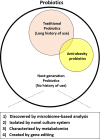An overview of microbiome based strategies on anti-obesity
- PMID: 30844145
- PMCID: PMC11900707
- DOI: 10.1002/kjm2.12010
An overview of microbiome based strategies on anti-obesity
Abstract
With the significant global obesity epidemic and emerging strong scientific evidence that connected gut microbiota to obesity, intervening obesity by targeting gut microbiota has become a trendy strategy. Particularly the application of probiotics has become remarkably popular because of their expected association with gut microbiota modulation. Although there are many literatures on the effects of probiotics in obese animal models, most of them reported the effects of probiotic bacteria on metabolic indications with limited information on anti-obesity itself. Besides, some probiotics have been shown to reduce certain metabolic symptoms but they failed to achieve weight loss. This report reviewed the current literatures on the anti-obesity effects of next-generation probiotics in various animal obesity models and discussed the beneficial potential of fecal microbiota transplantation in treating obesity in humans. The purpose of this article is to help guide further research improve the probiotic bacteria experiments in more precise animal obesity models by standardizing the anti-obesogenesis, obesity control, and treatment assays and hopefully the evidence-based investigations on harnessing gut microbiota through next-generation probiotics or fecal microbiota transplantation will develop new interventions to promote and achieve anti-obesity.
Keywords: microbiome; obesity; probiotics.
© 2019 The Authors. Kaohsiung Journal of Medical Sciences published by John Wiley & Sons Australia on behalf of Kaohsiung Medical University.
Conflict of interest statement
The authors have no conflicts of interest to report.
Figures
Similar articles
-
Gut microbiota: a target for intervention in obesity.Expert Rev Gastroenterol Hepatol. 2021 Oct;15(10):1169-1179. doi: 10.1080/17474124.2021.1963232. Epub 2021 Aug 6. Expert Rev Gastroenterol Hepatol. 2021. PMID: 34329563 Review.
-
The gut microbiota as a therapeutic target for obesity: a scoping review.Nutr Res Rev. 2022 Dec;35(2):207-220. doi: 10.1017/S0954422421000160. Epub 2021 Jun 8. Nutr Res Rev. 2022. PMID: 34100344
-
Gut microbiota and obesity: An opportunity to alter obesity through faecal microbiota transplant (FMT).Diabetes Obes Metab. 2019 Mar;21(3):479-490. doi: 10.1111/dom.13561. Epub 2018 Nov 20. Diabetes Obes Metab. 2019. PMID: 30328245 Review.
-
The Gut Microbiota: The Gateway to Improved Metabolism.Gastroenterol Clin North Am. 2016 Dec;45(4):601-614. doi: 10.1016/j.gtc.2016.07.001. Gastroenterol Clin North Am. 2016. PMID: 27837775 Free PMC article. Review.
-
Different Strategies Targeting Gut Microbiota for the Management of Several Disorders: A Sustainable Approach.Infect Disord Drug Targets. 2024;24(5):e160124225675. doi: 10.2174/0118715265267536231121095634. Infect Disord Drug Targets. 2024. PMID: 38317473 Review.
Cited by
-
What Should I Eat and Why? The Environmental, Genetic, and Behavioral Determinants of Food Choice: Summary from a Pennington Scientific Symposium.Obesity (Silver Spring). 2020 Aug;28(8):1386-1396. doi: 10.1002/oby.22806. Epub 2020 Jun 10. Obesity (Silver Spring). 2020. PMID: 32520444 Free PMC article. Review.
-
The Influence of Gut Microbiota on the Cardiovascular System Under Conditions of Obesity and Chronic Stress.Curr Hypertens Rep. 2021 May 20;23(5):31. doi: 10.1007/s11906-021-01144-7. Curr Hypertens Rep. 2021. PMID: 34014393 Free PMC article. Review.
-
Characteristics of gut microbiota in people with obesity.PLoS One. 2021 Aug 10;16(8):e0255446. doi: 10.1371/journal.pone.0255446. eCollection 2021. PLoS One. 2021. PMID: 34375351 Free PMC article.
-
Microbiota analysis for risk assessment: evaluation of hazardous dietary substances and its potential role on the gut microbiome variability and dysbiosis.EFSA J. 2022 May 25;20(Suppl 1):e200404. doi: 10.2903/j.efsa.2022.e200404. eCollection 2022 May. EFSA J. 2022. PMID: 35634548 Free PMC article.
-
Characterization of metabolites and biomarkers for the probiotic effects of Clostridium cochlearium on high-fat diet-induced obese C57BL/6 mice.Eur J Nutr. 2022 Jun;61(4):2217-2229. doi: 10.1007/s00394-022-02840-z. Epub 2022 Mar 20. Eur J Nutr. 2022. PMID: 35306583
References
-
- Dina C, Meyre D, Gallina S, Durand E, Korner A, Jacobson P, et al. Variation in fto contributes to childhood obesity and severe adult obesity. Nat Genet. 2007;39(6):724–726. - PubMed
Publication types
MeSH terms
Substances
Grants and funding
LinkOut - more resources
Full Text Sources
Medical



